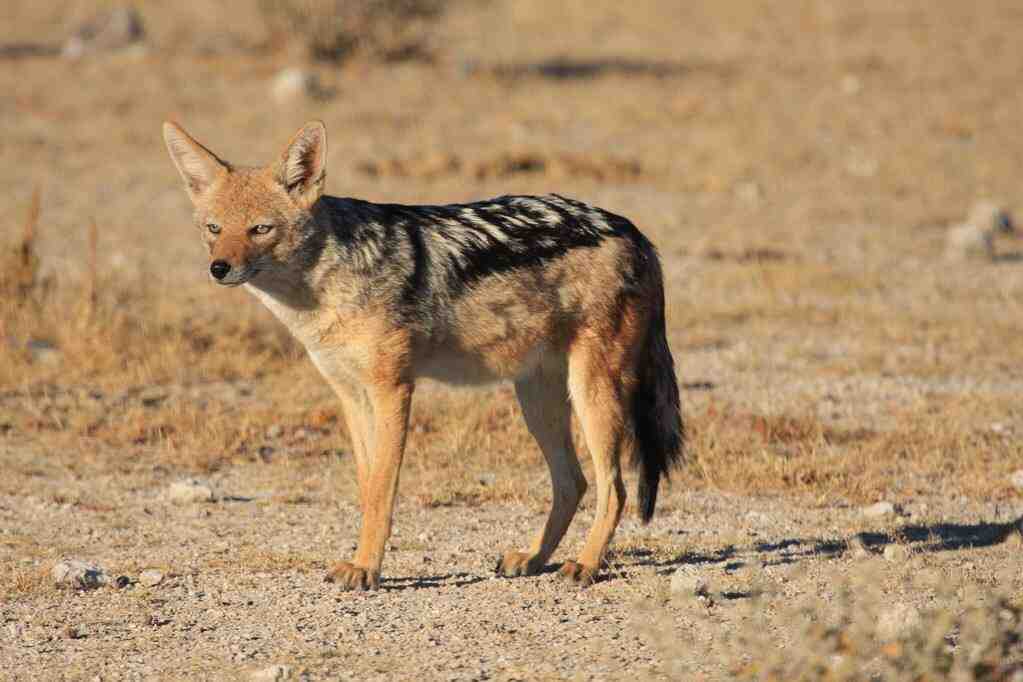Cuon alpinus
IUCN
LCBasic Information
Scientific classification
- name:Cuon alpinus
- Scientific Name:Dhole,Jackal, Indian wild dog, Asiatic wild dog, red dog
- Outline:Carnivora
- Family:Carnivora Canidae Cuon
Vital signs
- length:85-130厘米
- Weight:15-20kg
- lifetime:10-12年,圈养可达16年
Feature
捕猎能力最强和最难在动物园中繁殖的犬科动物之一
Distribution and Habitat
曾广布于亚洲东部、北部、中部、南部和东南部,但从20世纪中期开始,种群和分布范围急剧南缩,已在俄罗斯、朝鲜、蒙古、中亚和我国东北绝迹;在国外仅分布于孟加拉国、不丹、柬埔寨、印度、印度尼西亚、老挝、马来西亚、缅甸、尼泊尔、泰国。
我国的豺也濒临绝迹,在2012-2022年十年间,仅在西藏、青海、甘肃、新疆、四川、云南的26个县市记录到豺的确切影像。其中藏东南的雅鲁藏布大峡谷国家级自然保护区、青海的三江源国家公园 、青海与甘肃交界的祁连山国家公园等,都有较多的记录。
豺在各个地区的密度均较为稀疏,数量远不如狐、狼等那样多。栖息的环境也十分复杂,无论是热带、温带和寒带的各种森林,还是海拔2500-3500米的亚高山林地,甚至海拔5300米的高山草甸和高山裸岩等地带,都能发现它的踪迹;但与狼不同,它们无法适应荒漠。不过,豺最喜好的生境还是森林覆盖的山地和丘陵地区。它居住岩石缝隙、天然洞穴,或隐匿在灌木丛薮之中,但不会自己挖掘洞穴。
Appearance
头宽,额扁平而低,吻部较短,耳半圆形;额骨的中部隆起,所以从侧面看上去,从额头到吻部的头顶轮廓没有明显的凹陷,不像其他犬类那样有显著的脑门。豺的四肢也比狼稍短,有助于在山地峭壁间攀岩,以及林间穿行;尾较粗,毛蓬松而下垂,呈棕黑色,类似狐尾,尖端为黑色或棕色。体毛厚密而粗糙,体色随季节和产地的不同而异,一般头部、颈部、肩部、背部,以及四肢外侧等处的毛色为棕褐色,腹部及四肢内侧为淡白色、黄色或浅棕色。北方的豺,外表粗犷,白色的腹部和红棕色的背部界限分明,对比明显,而且颊部和吻部多白色,两颊和颈部毛发很长,显得脸部和头颈很宽;南方的豺,体型苗条,腹部多为浅黄色,与背部的颜色对比不如北方豺明显,而且很多个体的吻部和颊部为黑色,头颈也没有北方豺那样的鬃毛状的长毛,显得脸型精瘦。下颌每侧具2个臼齿;在犬科中,只有南美的薮犬的下臼齿也是每侧2枚,其余种类的下臼齿都是每侧3枚甚至4枚。
豺的交配季节一般发生在9至2月,在繁殖季节,雄兽和雌兽多成对活动。雌兽的妊娠期约为66-69天左右,产仔则在冬季,每胎产4-6仔,最多为9仔。
Details
The appearance of jackals is similar to that of wolves and dogs, but they are slightly smaller than wolves and much larger than red foxes.

The tooth structure of the jackal shows that it is more carnivorous than the wolf. The jackal is good at swimming, jumping and climbing. It is the most capable and flexible species among the existing canids, and it is also one of the canids with the strongest hunting ability.
Due to habitat destruction and human hunting, the reduction of wild prey such as ungulates has forced jackals to expand their range of activities to villages and steal livestock. People often kill them as pests, causing them to be endangered in various places. In addition, jackals are also vulnerable to infectious diseases such as canine distemper brought by domestic dogs. Jackals have a wide range of activities, so they are more likely to conflict with humans and come into contact with domestic dogs. Therefore, the number of jackals in the world has dropped sharply and they are on the verge of extinction. IUCN estimated in 2015 that the number of mature individuals in the world was only 949-2215.
In the past, jackals were treated as pests in various places and were not protected, resulting in the extinction of jackals in Northeast China and South China. China's list of key protected wild animals first listed jackals as national Class II protected animals, and then upgraded them to Class I in 2021, prohibiting arbitrary hunting. With the increase in forest-type protected areas, jackals have reappeared in some areas. For example, in the Heishui River Nature Reserve in Sichuan, as residents moved out of the reserve and vegetation recovered, more than 10 jackals can be seen in social activities. They mainly feed on aging individuals such as takin, serow, goral and tufted deer, and have a certain effect on balancing and rejuvenating ungulate populations. In some mountainous areas, because wild boars, hog badgers and badgers harm corn crops, jackals are regarded as divine jackals, which helps them control the damage of wild animals to crops and have a simple sense of protection.
Jackals are one of the most difficult canids to breed in zoos. Because they are extremely sensitive to the environment, they need a large area of activity area, enough hiding space, a commanding height to overlook tourists, and a pool; in addition, there must be more than 3 jackals in the same cage to reproduce normally. Therefore, the jackals in my country's zoos have died out one after another; in 2022, only the Zhongnan Baicao Garden in Anji, Zhejiang, has a captive breeding population of jackals from abroad, and a few zoos such as Shijiazhuang Zoo, Guangzhou Zoo, Shanghai Zoo, and Kunming Zoo also have a small number of jackals. In North America, only a few zoos such as the San Diego Wild Animal Park, the Bronx Zoo in New York, the Minnesota Zoo, and The Wilds still breed them. In 2022, the captive population of jackals is mainly in zoos in Europe, India and other countries. Among them, the bloodline of European captive jackals mainly comes from two jackals introduced from Qinghai, my country by the Moscow Zoo in the 1950s, and a jackal of unknown origin from a breeding farm in the United States.
Listed in the 2015 Red List of Endangered Species of the World Conservation Union (IUCN) ver 3.1 - Endangered (EN).
Listed in the CITES I level protected animals of the Convention on International Trade in Endangered Species of the United Nations.
The jackal was upgraded from the second level protected wildlife of the state to the first level of the state in the List of National Key Protected Wildlife.
Protect wildlife and stop eating game.
Maintaining ecological balance is everyone's responsibility!








